The Internet of Things (IoT) refers to the interconnection of everyday objects through the same Internet, allows different devices, sensors and systems to interact to share information in an automated way and has the ability to collect large amounts of data in time. real.
Article Content
• How does the Internet of Things work and what technologies make it possible? Sensors, networks, platforms and protocols
It has the potential to improve different aspects of people's lives. In the health sector, connected medical devices serve to constantly monitor a patient's vital signs; Likewise, as with transportation, connected vehicles communicate with each other, in accordance with the road structure that serves to improve traffic efficiency and safety.
• What benefits does the Internet of Things have for improving quality of life, efficiency and sustainability? Applications, examples and success stories
The Internet has connected the world by creating connections that were not possible before. The internet or IoT has fundamentally changed people's lives with motion detection sensors. A data processor and an internet connection that can range from devices to intelligent infrastructures connected with software components and services that make it possible to do those useful “things.”
• The internet of things for health and well-being: how to monitor, prevent and treat diseases and healthy habits
The Internet of Medical Things or Lot is the sensorization of medical devices to collect the data extracted from the devices to analyze them and offer a better service to patients and health professionals. The constant connection to the network is an advantage, increased efficiency and productivity thanks to the Internet, monitoring can be achieved. Prevent and treat diseases as well as healthy habits.
• The internet of things for the home and the smart city: how to automate, control and optimize urban services and resources

The IoT makes it possible to monitor and manage urban infrastructure, water supply, energy, lighting and transportation, with sensors and connected devices that collect data in real time. Facilitating decision making and optimization of available resources.
• The internet of things for industry and agriculture: how to improve the productivity, quality and safety of processes and products
They use sensors and smart devices with which data on crops can be collected. Performance and quality, as well as the environment and soil type, temperature and humidity. Technology in agriculture includes vehicles, robotics, satellites, computers. mobile devices and drones with the innovation of technological advances.
• The internet of things for the environment and energy: how to reduce consumption, emissions and ecological impact
The Internet of Things helps reduce CO2 emissions, combat climate change and improve the quality of life of the population. The energy crises have made it clear that some countries need to stop being so dependent
teeth.
The role of IoT in energy saving can be key to carrying out energy management. So that it is efficient and does not produce inequalities between countries.
What challenges and risks does the Internet of Things pose for security, privacy and ethics? Problems, threats and solutions
The Internet of Things IoT is the interconnection of devices, which allow them to communicate and share information with each other. The challenges and barriers of IoT are: data security, identity management, mobile device verification, network security and its components, with the risks, threats and solutions that this poses.
• What trends and developments are expected in the future of the Internet of Things? Innovations, projections and opportunities
The main trend that is presented as a novelty every day is generative artificial intelligence. 5G networks, voice interface, edge computing as well as digital twins.
These are some of the technologies that are trending in 2023 and that will have an impact in the next five years. With preferences to the currents that lean towards different purposes in a period of time and in a certain place.






